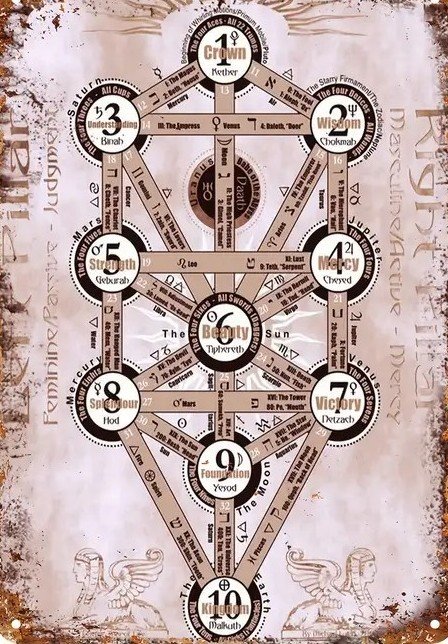
The Qabalah, also spelled Kabbalah or Cabala, is a rich mystical tradition rooted in Jewish spirituality that delves into the nature of divinity, the universe, and the human soul. It provides a symbolic framework for understanding the interconnectedness of existence and offers profound spiritual insights through its teachings, texts, and practices. Over centuries, the Qabalah has influenced various esoteric traditions, including Hermeticism, Western occult systems, and modern New Age movements.
Historical Development
The origins of the Qabalah date back to early Jewish mysticism, emerging between the 12th and 13th centuries in Spain and Provence. Its name, derived from the Hebrew word for “reception” or “tradition,” signifies the oral transmission of wisdom. Early foundational texts include the Sefer Yetzirah (Book of Formation) and Bahir (Book of Brightness), which laid the groundwork for later developments.
The Zohar (Book of Splendor), written by Moses de León in the late 13th century, is regarded as the most influential Qabalistic text. It explores hidden meanings in the Torah, addressing the creation of the universe, the nature of God, and the soul’s spiritual journey. In the 16th century, Isaac Luria introduced Lurianic Qabalah, emphasizing concepts like Tzimtzum (divine contraction) and Shevirat HaKelim (the shattering of vessels), explaining the existence of evil and spiritual restoration, known as Tikkun.
Core Concepts
Central to Qabalistic teachings is the concept of Ein Sof, meaning “the Infinite.” It represents the boundless and unknowable nature of God. Divine light flows from the Ein Sof through ten spheres, or Sephiroth, on the Tree of Life—a diagram that symbolizes the cosmic and spiritual structure of the universe.
The Tree of Life
The Tree of Life is the most iconic symbol in Qabalah, illustrating the relationship between the divine, humanity, and the material world. It consists of ten interconnected Sephiroth, each representing aspects of divine emanation and human experience. Together, they form a spiritual map of creation and the soul’s journey.
Tarot and the Tree of Life
Hermetic Qabalists see the cards of the tarot as keys to the Tree of Life. The 22 cards including the 21 Trumps plus the Fool or Zero card are often called the “Major Arcana” or “Greater Mysteries” and are seen as corresponding to the 22 Hebrew letters and the 22 paths of the Tree; the ace to ten in each suit correspond to the ten Sephiroth in the four Qabalistic worlds; and the sixteen court cards relate to the classical elements in the four worlds. While the sephiroth describe the nature of divinity, the paths between them describe ways of knowing the Divine.
The Ten Sephiroth
- Kether (Crown): Represents unity and divine will, the source of all existence.
- Chokmah (Wisdom): Symbolizes dynamic, masculine energy and pure inspiration.
- Binah (Understanding): Reflects feminine energy, providing structure and form to creation.
- Chesed (Mercy): Embodies unconditional love, generosity, and expansive giving.
- Geburah (Severity): Represents strength, discipline, and divine justice, balancing Chesed.
- Tiphereth (Beauty): The heart of the Tree, signifying harmony, compassion, and spiritual illumination.
- Netzach (Victory): A sphere of endurance, creativity, and persistence.
- Hod (Glory): Reflects intellect and communication, emphasizing understanding and analysis.
- Yesod (Foundation): Connects higher spheres to the material world; symbolizes emotions and manifestation.
- Malkuth (Kingdom): The final sphere, representing the physical realm and completion of divine emanation.
Structure and Columns
The Sephiroth are arranged into three columns:
- Pillar of Mercy: Expansive, active qualities (Chokmah, Chesed, Netzach).
- Pillar of Severity: Restrictive, introspective qualities (Binah, Geburah, Hod).
- Pillar of Balance: Harmonizing qualities (Kether, Tiphereth, Yesod, Malkuth).
The 22 Paths
The 22 paths connecting the Sephiroth correspond to the Hebrew alphabet and the Major Arcana of Tarot in Hermetic Qabalah. These paths represent challenges or stages of spiritual growth, linking divine attributes within the Tree.
Applications and Practices
Qabalistic practices include meditation, prayer, and study of sacred texts, along with techniques like Gematria (numerical analysis) to uncover hidden meanings. In Western esotericism, Qabalah integrates alchemy, astrology, and Tarot, extending its teachings to a broader audience.
Modern Relevance
The Qabalah remains relevant today as a source of spiritual wisdom and personal growth. Its teachings provide profound insights into the interconnectedness of existence and the soul’s quest for enlightenment. Whether explored as a mystical tradition, philosophical system, or spiritual tool, the Qabalah continues to inspire seekers worldwide.
